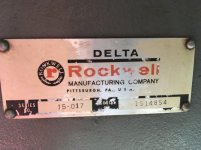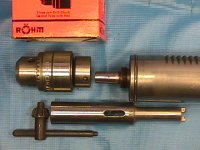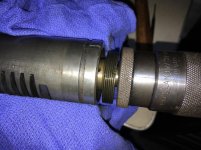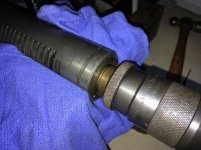I'm new. Thanks in advance for any help. I have (just purchased) an older (1970's) Rockwell floor model drill press with a keyless chuck. I see a roll pin through the shaft. I can't get the chuck off using a wedge. Removing the roll pin didn't help. What am I missing? I haven't figured out yet how to post pics.
How to install the app on iOS
Follow along with the video below to see how to install our site as a web app on your home screen.
Note: This feature may not be available in some browsers.
You are using an out of date browser. It may not display this or other websites correctly.
You should upgrade or use an alternative browser.
You should upgrade or use an alternative browser.
Older Rockwell drill press - can't get the chuck off.
- Thread starter Lugnutz65
- Start date
- Replies 43
- Views 19,600
Scottl
Diamond
- Joined
- Nov 3, 2013
- Location
- Eastern Massachusetts, USA
Many of the older ones were threaded, male threads on the spindle and female on the chuck.
First of all, "an older (1970's) Rockwell floor model drill press" is far too vague. There should be a nameplate with a model number. After you have that try here to see if they list a manual for that or similar model.
Rockwell Manufacturing Co. - Publication Reprints | VintageMachinery.org
First of all, "an older (1970's) Rockwell floor model drill press" is far too vague. There should be a nameplate with a model number. After you have that try here to see if they list a manual for that or similar model.
Rockwell Manufacturing Co. - Publication Reprints | VintageMachinery.org
CarlBoyd
Hot Rolled
- Joined
- Jul 16, 2007
- Location
- Orlando, Florida
I'm new. Thanks in advance for any help. I have (just purchased) an older (1970's) Rockwell floor model drill press with a keyless chuck. I see a roll pin through the shaft. I can't get the chuck off using a wedge. Removing the roll pin didn't help. What am I missing? I haven't figured out yet how to post pics.
Pictures really help. There is a sticky post at the top that tells you how do do this. http://www.practicalmachinist.com/v...tory/scans-manuals-books-links-images-151257/
1) Does the spindle have a female or male taper? Extend the quill down and look for a slot. Show us a picture.
2) what kind of wedge are you using and where? Again, pictures
3) what "shaft" has the pin, and where in the shaft? Need I say pictures?
CarlBoyd
Thanks for the replies. I'm at my home computer now and can post photos.
Rockwell drill press - Model 62-010 Series # 15-017
Year ????
Llambrich chuck 1/32 - 1/2 Keyless chuck but knurled ring at top of chuck spins free and also pistons up and down.
Took it apart last night but cant get the chuck off. I thought maybe it had a stem that was secured by the roll pin. I couldn't get a drift onto the roll pin until I took it apart. However, removing the roll pin didn't seem to free anything up.
Below the roll pin is a male threaded section but nothing there to thread onto it.
This drill press came from a machine shop that closed down. I suspect they rigged it up to work with whatever they had laying around. The chuck jaws move freely. The only way I can get the jaws tight on a bit is to open the top cover and hold the belt wheel (name???) and turn the chuck tight.
I want to replace the current chuck with a key chuck.
I don't have a working knowledge of the names of the parts in the pics, so please be patient with me. I'm a pretty fast learner (most of the time).
What is the name of the sleeve that has the upper and lower bearings?
What is the name of the shaft that the chuck is pressed onto?
Thanks,
Jay

This pic shows the threaded ring the screws inside the tube just beneath the lower bearing. Once that was out, I was able to slide the shaft down far enough to drive the roll pin out.
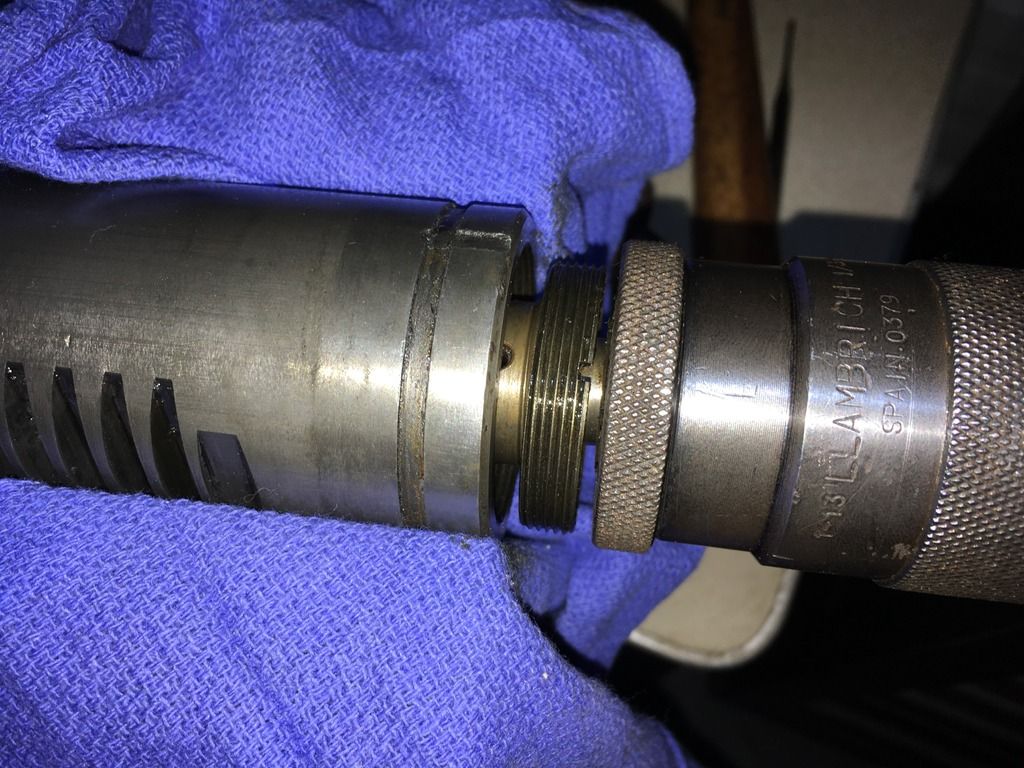
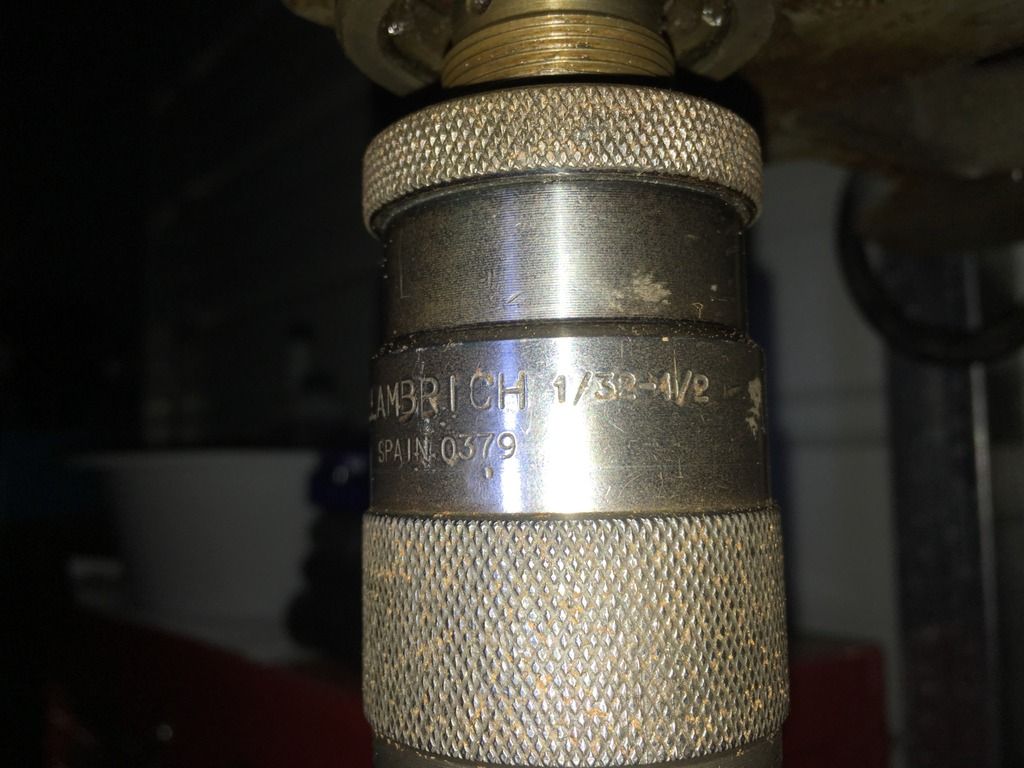
Rockwell drill press - Model 62-010 Series # 15-017
Year ????
Llambrich chuck 1/32 - 1/2 Keyless chuck but knurled ring at top of chuck spins free and also pistons up and down.
Took it apart last night but cant get the chuck off. I thought maybe it had a stem that was secured by the roll pin. I couldn't get a drift onto the roll pin until I took it apart. However, removing the roll pin didn't seem to free anything up.
Below the roll pin is a male threaded section but nothing there to thread onto it.
This drill press came from a machine shop that closed down. I suspect they rigged it up to work with whatever they had laying around. The chuck jaws move freely. The only way I can get the jaws tight on a bit is to open the top cover and hold the belt wheel (name???) and turn the chuck tight.
I want to replace the current chuck with a key chuck.
I don't have a working knowledge of the names of the parts in the pics, so please be patient with me. I'm a pretty fast learner (most of the time).
What is the name of the sleeve that has the upper and lower bearings?
What is the name of the shaft that the chuck is pressed onto?
Thanks,
Jay

This pic shows the threaded ring the screws inside the tube just beneath the lower bearing. Once that was out, I was able to slide the shaft down far enough to drive the roll pin out.


Attachments
Many of the older ones were threaded, male threads on the spindle and female on the chuck.
First of all, "an older (1970's) Rockwell floor model drill press" is far too vague. There should be a nameplate with a model number. After you have that try here to see if they list a manual for that or similar model.
Rockwell Manufacturing Co. - Publication Reprints | VintageMachinery.org
Your LINK has proved to be very helpful. My drill press seems to be just like THIS ONE.
The chuck is different. Perhaps the chuck I have is not the original one.
rusty old tools
Hot Rolled
- Joined
- Jun 13, 2010
- Location
- Pomona CA USA
Chucks usually have the mount type stamped on the side, if it says something like jt 33 or 33 taper, 6a taper or possibly just 6a, if it's threaded it may say 1/2-20 or something similar what are the markings on the chuck? Also extend the quill all the way down, if you see a slot it may be a morse taper, but I don't think many Rockwell drills used morse taper spindles, if any did.
L Vanice
Diamond
- Joined
- Feb 8, 2006
- Location
- Fort Wayne, IN
rusty old tools;2984315...Also extend the quill all the way down said:
I posted pictures and a bunch of info around 3PM today. I guess the moderator has not
reviewed it yet. Seems anything with an external link needs a mod review.
I'll post what I posted earlier.
Rockwell floor model drill press Model 62-010 Series 15-017
I downloaded the shop manual from the earlier link (thanks) and it looks like maybe a late 1960's model.
I disassembled enough to remove the spindle from the quill. That allowed me to remove the roll pin but that doesn't seem to be the issue. This drill press was purchased from a machine shop that closed down and they said it was one of the first tools they had, so I doubt the chuck is the original one. The bottom of the spindle has some male threads that according to the manual would be used for an adapter, but not the chuck. The manual shows how to remove the chuck with a brass drift. I tried but wasn't successful.
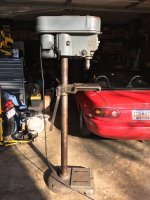




reviewed it yet. Seems anything with an external link needs a mod review.
I'll post what I posted earlier.
Rockwell floor model drill press Model 62-010 Series 15-017
I downloaded the shop manual from the earlier link (thanks) and it looks like maybe a late 1960's model.
I disassembled enough to remove the spindle from the quill. That allowed me to remove the roll pin but that doesn't seem to be the issue. This drill press was purchased from a machine shop that closed down and they said it was one of the first tools they had, so I doubt the chuck is the original one. The bottom of the spindle has some male threads that according to the manual would be used for an adapter, but not the chuck. The manual shows how to remove the chuck with a brass drift. I tried but wasn't successful.





More pics
This is a keyless chuck and the top knurled ring spins freely and also slides up and down about 1/2" without any way to use it to tighten the chuck jaws. To tighten the chuck jaws on a drill bit, I must open the top lid and hold the belt wheel to keep the spindle from turning and then do a final twist of the chuck.


This is a keyless chuck and the top knurled ring spins freely and also slides up and down about 1/2" without any way to use it to tighten the chuck jaws. To tighten the chuck jaws on a drill bit, I must open the top lid and hold the belt wheel to keep the spindle from turning and then do a final twist of the chuck.


L Vanice
Diamond
- Joined
- Feb 8, 2006
- Location
- Fort Wayne, IN
My picture in post #5 shows what your spindle, the 33 Jacobs taper with male thread for a locking collar, looks like with the chuck removed. The chuck in my picture has a female 33JT and a rotating collar that screws on to the male thread to safely retain the chuck. The collar will also let you easily remove the chuck without needing wedges or a hammer. Turning the collar while preventing the chuck from rotating unscrews the collar and forces the chuck off the taper.
Your Spanish keyless chuck is not original equipment for your machine. As you have found, such a chuck, lacking the threaded collar, is difficult to remove. You have also found that the chuck is not a good one. The OEM chuck was a USA- made Jacobs 1/2" capacity with the 33JT and collar, nearly identical to the NOS German Rohm chuck in my picture. Such chucks are expensive now and may only be available new in the Jacobs brand version, of Chinese make and questionable quality.
On my drill press, I installed a 2MT spindle like the one in the picture, which makes it easy to change chucks and also allows you to use drill bits with taper shanks.
Back in the 1960's, the 33JT locking collar spindles were advertised as easy to change the chuck over for other tooling so that the machine could do things other than drill holes. I had a 1/4" collet chuck for router bits, a drum sander, and a 1/2-20 male threaded arbor for grinding or buffing wheels for my new at the time 1962 drill press of a different make. Rockwell sold the same tooling for their machine.
Larry
Your Spanish keyless chuck is not original equipment for your machine. As you have found, such a chuck, lacking the threaded collar, is difficult to remove. You have also found that the chuck is not a good one. The OEM chuck was a USA- made Jacobs 1/2" capacity with the 33JT and collar, nearly identical to the NOS German Rohm chuck in my picture. Such chucks are expensive now and may only be available new in the Jacobs brand version, of Chinese make and questionable quality.
On my drill press, I installed a 2MT spindle like the one in the picture, which makes it easy to change chucks and also allows you to use drill bits with taper shanks.
Back in the 1960's, the 33JT locking collar spindles were advertised as easy to change the chuck over for other tooling so that the machine could do things other than drill holes. I had a 1/4" collet chuck for router bits, a drum sander, and a 1/2-20 male threaded arbor for grinding or buffing wheels for my new at the time 1962 drill press of a different make. Rockwell sold the same tooling for their machine.
Larry
If you explained how I can get my chuck off, I missed it. The knurled ring spins freely and seems to be useless.My picture in post #5 shows what your spindle, the 33 Jacobs taper with male thread for a locking collar, looks like with the chuck removed. The chuck in my picture has a female 33JT and a rotating collar that screws on to the male thread to safely retain the chuck. The collar will also let you easily remove the chuck without needing wedges or a hammer. Turning the collar while preventing the chuck from rotating unscrews the collar and forces the chuck off the taper.
Your Spanish keyless chuck is not original equipment for your machine. As you have found, such a chuck, lacking the threaded collar, is difficult to remove. You have also found that the chuck is not a good one. The OEM chuck was a USA- made Jacobs 1/2" capacity with the 33JT and collar, nearly identical to the NOS German Rohm chuck in my picture. Such chucks are expensive now and may only be available new in the Jacobs brand version, of Chinese make and questionable quality.
On my drill press, I installed a 2MT spindle like the one in the picture, which makes it easy to change chucks and also allows you to use drill bits with taper shanks.
Back in the 1960's, the 33JT locking collar spindles were advertised as easy to change the chuck over for other tooling so that the machine could do things other than drill holes. I had a 1/4" collet chuck for router bits, a drum sander, and a 1/2-20 male threaded arbor for grinding or buffing wheels for my new at the time 1962 drill press of a different make. Rockwell sold the same tooling for their machine.
Larry
Chip Chester
Diamond
- Joined
- Dec 13, 2007
- Location
- Central Ohio USA
So, will that knurled ring thread onto the threads at the top of the spindle, just under the casting? If so, thread it up there, then put a spacer between the ring and the chuck (with the split pin removed) and then unscrew the threaded ring, pushing down on the chuck. With vigor. And maybe a torque amplification device, like a strap wrench or (if you must) pliers that lock and don't slip at all (or else you'll damage the ring.) Keep in mind this is a guess, so if your local observation says 'nah', then don't do it.
Chip
Chip
So, will that knurled ring thread onto the threads at the top of the spindle, just under the casting? If so, thread it up there, then put a spacer between the ring and the chuck (with the split pin removed) and then unscrew the threaded ring, pushing down on the chuck. With vigor. And maybe a torque amplification device, like a strap wrench or (if you must) pliers that lock and don't slip at all (or else you'll damage the ring.) Keep in mind this is a guess, so if your local observation says 'nah', then don't do it.
Chip
The knurled ring won't thread onto the threads above it. I might just need to deliver a harder blow with a drift to knock the chuck off. I've been afraid of damaging bearings or the spindle. Now that I have a manual, I have a better idea of how the chuck might come off.
L Vanice
Diamond
- Joined
- Feb 8, 2006
- Location
- Fort Wayne, IN
If you explained how I can get my chuck off, I missed it. The knurled ring spins freely and seems to be useless.
You may need a bigger hammer.
Take the spindle out of the quill. Put the roll pin back where you found it. Get a pair of Jacobs chuck removal wedges that fit a 33JT. Apply the wedges between the top of the chuck and the male threaded collar. Rest one wedge on an anvil and hit the other wedge. Scrap that junk chuck.
Then get a 2MT spindle and put it in the quill.
Larry
k3vyl
Stainless
- Joined
- Feb 13, 2008
- Location
- newark DE USA
I have that same drill press with the pin spanner ring on the chuck. I tried the easy removal method that Larry mentioned using an adjustable pin spanner and a brass hammer. It's not an easy removal thing. I did not want to hit it hard because of the bearing and it didn't want to come apart by tapping the spanner. You are probably going to have to put it in a soft jaw vise and smack it.
L Vanice
Diamond
- Joined
- Feb 8, 2006
- Location
- Fort Wayne, IN
I have that same drill press with the pin spanner ring on the chuck. I tried the easy removal method that Larry mentioned using an adjustable pin spanner and a brass hammer. It's not an easy removal thing. I did not want to hit it hard because of the bearing and it didn't want to come apart by tapping the spanner. You are probably going to have to put it in a soft jaw vise and smack it.
The original chucks and attachments do not need a hammer to remove them.
A hammer is the usual tool to hit the wedges to remove chucks without the threaded locking collar. I have squeezed the wedges in a big vise and sometimes that worked. Sometimes, I drilled through the chuck body from between the jaws and used a pin and hydraulic press to get a chuck off its arbor. Sometimes, I just scrapped the chuck and the arbor upon which it was stuck.
There are several ways to apply torque to install and remove the original locking collar type chucks without using a hammer. You can use two pin spanners, one in a key hole in the chuck body and one in the hole in the chuck locking collar. As you can see in the picture in post #5, the original chuck key has a pin turned on the end of the key handle that fits the hole in the locking collar. You can grip a piece of 1/2" hex steel in the chuck and use a 1/2" box end wrench to keep the spindle from turning while you apply torque to the locking collar. If you are in the habit of changing the chuck over for another spindle adapter from time to time, you get a feel for how much to tighten the collar upon installation so that the tooling can be removed without much fuss.
The picture shows a simple pin spanner I made from a steel dowel and a piece of key stock. Factory-made spanners are not always easy to find in the size you need, so it pays to know how to make your own.
Larry

jim rozen
Diamond
- Joined
- Feb 26, 2004
- Location
- peekskill, NY
The picture shows a simple pin spanner I made from a steel dowel and a piece of key stock. Factory-made spanners are not always easy to find in the size you need, so it pays to know how to make your own.
Larry
View attachment 199825
Nice. I just spent the better part of a weekend making a specialized pin wrench to work on a lathe spindle bearing adjuster.
Cut the radius with a fly cutter which took quite a while. Yours was just heated and wrapped around the correct diameter?
Time saver for sure.
One thing I cannot figure out is the chuck in question is probably on a JT33 arbor, which means the spindle has a male
taper and the chuck a female taper. If the chuck really is trash it could be diassembled in place by unscrewing the two
body parts and then the remaining bit simply turned down until it could be slit and removed from the taper.
The only trick there is not cutting too deep.
The other issue is has a former owner modified this to accept a straight arbor chuck, what's tha roll pin doing in there?
L Vanice
Diamond
- Joined
- Feb 8, 2006
- Location
- Fort Wayne, IN
Jim, the roll pin is original and fastens the male thread collar to the spindle.
I did use a torch to hot bend the keystock around a steel bar while holding the two in a vise.
Even a low quality chuck probably has a hard body, so turning it off the spindle may require better equipment than the owner has at hand. Just getting the chuck apart may be pretty difficult.
Larry
I did use a torch to hot bend the keystock around a steel bar while holding the two in a vise.
Even a low quality chuck probably has a hard body, so turning it off the spindle may require better equipment than the owner has at hand. Just getting the chuck apart may be pretty difficult.
Larry
k3vyl
Stainless
- Joined
- Feb 13, 2008
- Location
- newark DE USA
Nice work on the pin spanner,I have a collection of them in a drawer. Some I have never used,but the drawer isn't full yet. I don't have the largest one of the adjustable,it stands in a corner rather than living in a drawer.
The trick I use for holding a drill chuck still is to put a long arm Allen wrench in the jaws. I learned the trick from an old machinist that rapaired portable power tools on the side. He would use an Allen wrench and a soft hammer to remove screw arbor chucks.
The trick I use for holding a drill chuck still is to put a long arm Allen wrench in the jaws. I learned the trick from an old machinist that rapaired portable power tools on the side. He would use an Allen wrench and a soft hammer to remove screw arbor chucks.
Last edited:
Similar threads
- Replies
- 54
- Views
- 1K
- Replies
- 26
- Views
- 2K



